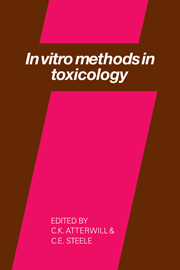Book contents
- Frontmatter
- Contents
- List of contributors
- Preface
- Introduction
- TARGET ORGAN TOXICITY
- In vitro methods in renal toxicology
- Ototoxicity
- Cultured cell models for studying problems in cardiac toxicology
- Use of the isolated rat heart for the detection of cardiotoxic agents
- Brain reaggregate cultures in neurotoxicological investigations
- Application of thryoid cell culture to the study of thyrotoxicity
- In vitro methods to investigate toxic lung disease
- Metabolism and toxicity of drugs in mammalian hepatocyte culture
- In vitro evaluation of haemic systems in toxicology
- GENERAL AND TOPICAL TOXICITY
- REPRODUCTIVE TOXICITY
- CONCLUSION
- Index
In vitro evaluation of haemic systems in toxicology
Published online by Cambridge University Press: 06 August 2010
- Frontmatter
- Contents
- List of contributors
- Preface
- Introduction
- TARGET ORGAN TOXICITY
- In vitro methods in renal toxicology
- Ototoxicity
- Cultured cell models for studying problems in cardiac toxicology
- Use of the isolated rat heart for the detection of cardiotoxic agents
- Brain reaggregate cultures in neurotoxicological investigations
- Application of thryoid cell culture to the study of thyrotoxicity
- In vitro methods to investigate toxic lung disease
- Metabolism and toxicity of drugs in mammalian hepatocyte culture
- In vitro evaluation of haemic systems in toxicology
- GENERAL AND TOPICAL TOXICITY
- REPRODUCTIVE TOXICITY
- CONCLUSION
- Index
Summary
GENERAL INTRODUCTION
The haemic system can be visualised as a dynamic three compartment model viz the bone marrow (generative) compartment, the vascular/lymphatic (distributive) compartment and the peripheral organ compartment. This is further sub-divided into cellular subsets comprising erythrocyte, platelet, polymorphonuclear, lymphocyte and monocyte. These cell lineages are defined on morphological, functional and clonogenic characteristics. The relationship of these cell lines to the three compartment model is shown in Figure 1. In addition, the micro-environment of the bone marrow compartment, necessary for normal haemopoiesis, and the haemostatic mechanisms of the peripheral blood compartment are considered parts of the haemic system. Toxic substances exert their effects on the haemic system in many ways. Some may affect only one cell line in one compartment, whilst others may affect all cell lines in all Compartments or alternatively all cell lines in one compartment.
The principle compartments and cellular subsets in which haematotoxicity has been demonstrated by a range of compounds are described below. Since the breadth of scientific and technical information available far exceeds the scope of a single Chapter, experimental methodology has been reviewed in detail for erythrocyte haemolysis and platelet aggregation tests only. The reader is referred to recent reviews cited in the bibliography for details of the many other various in vitro techniques available for the evaluation of the haemic system.
- Type
- Chapter
- Information
- In Vitro Methods in Toxicology , pp. 235 - 260Publisher: Cambridge University PressPrint publication year: 1987

